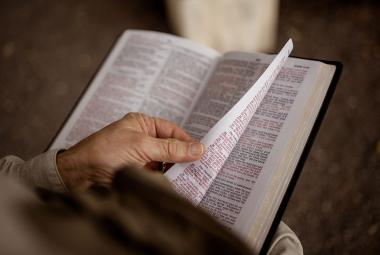Unquestionably, Isaiah has given us our most indispensable Old Testament prophetic tour de force and it is replete with exegetical discoveries and hermeneutic treasures.
There is a specific prophet that dominates the entire Bible: The Prophet Isaiah. As the “Royal Prophet,” he served under four kings,[1] with a span of future perspective that dwarfs all the rest. His vocabulary is the most extensive[2] and the integrity of his messages constitute a pillar of apologetic reasoning.
A Target of Controversy
Isaiah’s message was so controversial that the Ashkenazi Jews took Chapter 53 out of their Bible (the Tenakh). (However, the Sephardic Jews retained it; and when the Dead Sea Scrolls were ultimately discovered, there was a complete copy of Isaiah—with Chapter 53 right where it belonged: in the precise center of the second section.)
King Manasseh apparently had Isaiah cut in half. The modern critics have attempted a similar thing with their “Deutero-Isaiah” theories; however, only to the uninformed. (A careful study of John 12:38–40 shatters their profane speculations.)
Elegant Style
The flow of thought—unequalled elsewhere—also led to Handel’s classic choral masterpiece. We are also now blessed with a proprietary translation of the Paleo-Hebrew from the Dead Sea Scrolls by the acknowledged expert, Dr. Peter Flint, which is also the cornerstone of the new International Standard Version Bible (ISV). We paralleled our expositional commentary with the marvelous flow and rhythms of the ISV, which very much speak for themselves.
Messianic Insights
Among many things, Isaiah is also the most Messianic of all the Old Testament prophets. On every page, we gain a Messianic insight: every Christmas we celebrate the Hebraic parallelism: “for unto us a child is born; unto us a Son is given.”[3] (These are not synonymous: The child was human and his birth fulfilled in Bethlehem. The Son was divine, and given at Golgotha.)
For many, the “Holy of Holies” of the entire Old Testament is Isaiah Chapter 53. Located in the geometric center of the second section of Isaiah, the pivotal implications of this passage impacts the entire universe. Far more than simply our personal salvation is in view here; so much so that this passage has been set apart in a special study called The Fulcrum of the Entire Universe.
It is also Isaiah that explains the mystery of why Jesus was ostensibly not easily recognized after His resurrection.[4] (John’s enigmatic remark in John 21:12 is particularly puzzling!) And Isaiah also provides us with such a clear view of the Millennial Kingdom that it must certainly embarrass the amillennialists. There are passages that clearly commingle with the final chapters of the Book of Revelation.[5]
Cosmological Insights
It is Isaiah’s glimpse that the Creation was not originally “without form and void” (as implied in Genesis 1:2’s “tohu v’bohu”):
For thus saith the LORD that created the heavens; God himself that formed the earth and made it; he hath established it, he created it not in vain, he formed it to be inhabited: I am the LORD; and there is none else.[6]
Thus, this hints of a possible interval between Genesis 1:1 and 1:2 and, perhaps, an insight on the fall of Satan, which Isaiah details in Chapter 14.[7]
Isaiah also confronts the very cutting edge of cosmology as he refers to the “stretching of the heavens,”[8] which challenges the very fabric of space itself. (This, along with the profound implications of the “Zero Point Energy,” will be the subject of subsequent articles on the very foundations of subatomic physics.)
Other Eschatological Insights
It is by comparing the classic King James Version with the new International Standard Version (ISV) that we gain a more complete sense of the majestic flow of thought of this unique Royal Prophet. It is in Isaiah’s description of the ultimate destruction of Babylon which alters our perspective of what has yet to happen in the Middle East and world affairs.[9] It is in Isaiah’s allusion to the future role of the Sinim (China)[10] which further seems to suggest a major global outreach to the Gentiles as part of the final climax.
A Personal Letter
The Book of Isaiah also includes a personal letter from God to Cyrus the Great (written over a century before he was born), calling him by name and providing so many anticipated details of his career that it moved him to free the Jewish captives to return to their land.
That saith of Cyrus, He is my shepherd, and shall perform all my pleasure: even saying to Jerusalem, Thou shalt be built; and to the temple, Thy foundation shall be laid.[11]
For the Connoisseur
Unquestionably, Isaiah has given us our most indispensable Old Testament prophetic tour de force and it is replete with exegetical discoveries and hermeneutic treasures. (It was Isaiah that revealed that the Pharaoh of the Exodus was not an Egyptian.[12])
The Holy Spirit always rewards the diligent. When you want to feed on the Word of God, prepare yourself for a gourmet meal. It will be uniquely rewarding (and life-changing!).
This study is now available on DVD.
Notes:
- The reigns of Uzziah, Jotham, Ahaz, and Hezekiah covered a total of 81 years. ↩
- Ezekiel, 1535; Jeremiah, 1653; Psalmists, 2170; Isaiah, 2186. (Cf. Milton, Dante, Shakespeare who boast the largest English vocabularies on record.) ↩
- Isaiah 9:6. ↩
- John 20:14, 15; Luke 24:16–31, 35, 36–39; John 21:4, 12. Isaiah 50:6 provides the provocative clue. ↩
- Isaiah 65:17; 66:22; Revelation 21:1ff. ↩
- Isaiah 45:18. ↩
- Compare Isaiah 14:12–17 and Ezekiel 28:12–19. ↩
- Isaiah 42:5; 45:12; 51:13. ↩
- Isaiah 13 & 14, and Jeremiah 50 & 51 speak of a global role that has yet to happen; Zechariah 5:5–11 seems to bring this strange climax into focus. ↩
- Isaiah 49:12. ↩
- Isaiah 44:28. ↩
- Isaiah 52:4. (Cf. Isaiah 10:5, 24; 14:25; 19:23; 23:13; 30:31; 31:8). ↩






